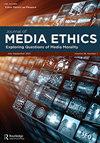To Show or Not to Show? The Depiction of Terror and Death in Nairobi
IF 1.1
3区 哲学
Q3 COMMUNICATION
引用次数: 0
Abstract
ABSTRACT This study examines the metajournalistic discourse reflected in the use of corpse images from the DusitD2 terror attack in Nairobi, Kenya, in January 2019. Drawing from concepts such as responsibility and resistance ethics, this study explores the viewpoints of Kenyan journalists and bloggers. Situated within qualitative research methodology, the findings suggest that the New York Times’ use of victims’ corpse images reflects a double standard and visual bias, and its defense of the news report can be considered an example of professional posturing. Conversely, sharing of perpetrators’ postmortem pictures produced mixed findings among audiences. While online circulation was blamed on bloggers’ inexperience, it was also seen as a sign of victory for the value of visual evidence. This study also contributes to the scholarship on use of graphic images by drawing on African ethical systems and just war theory.展示还是不展示?内罗毕的恐怖与死亡描写
本研究考察了2019年1月肯尼亚内罗毕DusitD2恐怖袭击中尸体图像的使用所反映的元新闻话语。本研究从责任与抵抗伦理等概念出发,探讨肯尼亚记者与部落客的观点。在定性研究方法中,研究结果表明,《纽约时报》对受害者尸体图像的使用反映了双重标准和视觉偏见,其对新闻报道的辩护可以被认为是专业姿态的一个例子。相反,分享犯罪者的死后照片在观众中产生了不同的结果。虽然网上发行量被归咎于博主缺乏经验,但这也被视为视觉证据价值的胜利标志。本研究还通过借鉴非洲伦理体系和正义战争理论,对图形图像的使用做出了贡献。
本文章由计算机程序翻译,如有差异,请以英文原文为准。
求助全文
约1分钟内获得全文
求助全文

 求助内容:
求助内容: 应助结果提醒方式:
应助结果提醒方式:


